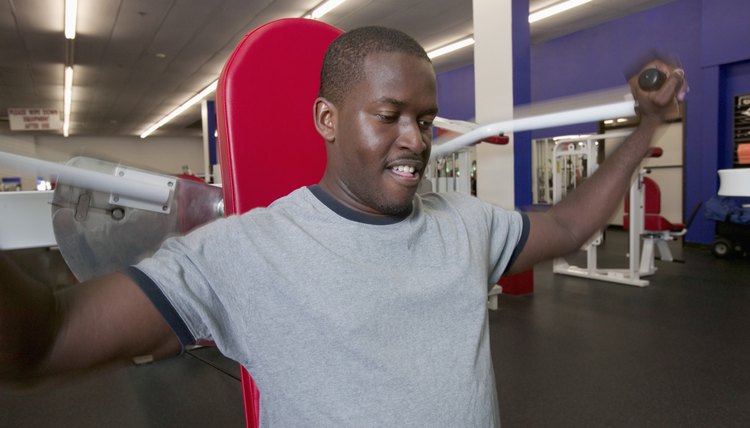AC Joint Injuries: Weight-Lifting Exercises to Avoid

The acromioclavicular joint, also known as the AC joint, is at the topmost point of your shoulder where the clavicle attaches to a piece of bone that runs from the scapula across the top of the shoulder. AC joint injuries are caused by repetitive trauma, falls on the shoulder joint or certain weightlifting exercises. But you don't have to abandon your weightlifting program. Simply modify your technique and avoid the exercises that cause discomfort.
The Bench Press
Avoid full range of motion barbell or dumbbell bench presses. Excessive stress on the AC joint occurs when your elbows drop below your body on the downward motion. Using heavy weights compounds the problem. The bench press is often seen as a test of strength by weightlifters, and many do the exercise too frequently with near-maximal weights. Limit the stress on your AC joint by not bench pressing every week. Use lighter weights, and don't bounce the bar off your chest to assist the lift.
Chest Flyes
Flat bench or incline bench dumbbell flyes with dumbbells lowered in a wide arc out to the sides overextends the shoulder joints. The stress and risk of injury to the AC joint increases if your elbows drop below your body to get a full stretch of the pectorals. Machine flyes gripping a bar or handles or with forearms against a pad also overextend your shoulder joints on the negative phase of the movement as your elbows travel beyond your shoulder joints.
Behind-the-Neck Barbell Press
The behind-the-neck barbell press was a staple shoulder exercise for weightlifters and old-time bodybuilders such as Reg Park and Arnold Schwarzenegger in the 1960s and 70s, and even relatively recent bodybuilders such as Lee Haney and Dorian Yates in the 1990s. But it is an exercise you should avoid. According to fitness trainer Nick Nilsson writing for Bodybuilding.com, the exercise involves extreme external rotation of the shoulder joints -- moving your shoulders away from the midline of your body -- and limits the ability of the rotator cuff muscles to stabilize the shoulder joints. Pulling your elbows beyond your shoulders as you perform the exercise overextends your shoulder joints and places excessive stress on your AC joints.
Behind-the-Head Lat Pulldowns
Avoid behind-the-head lat pulldowns. Over-extending your shoulder joints with your elbows behind your shoulders as you pull the bar down increases the risk of injuring your AC joints. Additionally, Nilsson says the extreme external rotation of your shoulder joints inhibits your rotator cuff muscles from stabilizing your shoulder joints.
Lateral Raises
Don't include dumbbell, cable or machine lateral raises for your deltoids in your weightlifting program if you have any pain in your AC joint. Exercises that involve moving your arm laterally from the midline of your body exacerbate AC joint injuries.
Upright Rows
Avoid barbell and dumbbell upright rows for your deltoids and upper trapezius. The internal rotation of your shoulder joints -- moving your shoulders toward the midline of your body -- with added resistance creates pressure on your AC joint.
Other Exercises
Bar dips for the chest and triceps place considerable stress on the AC joint, particularly if your body drops too low on the downward motion – upper arms beyond parallel to the floor. The risk of further injury to your AC joint outweighs any potential benefit of the exercise. Behind-the-neck pullups for your lats involve extreme external rotation of your shoulders and place excessive pressure on your AC joints.
References
Writer Bio
Ollie Odebunmi's involvement in fitness as a trainer and gym owner dates back to 1983. He published his first book on teenage fitness in December 2012. Odebunmi is a black belt in taekwondo and holds a bachelor's degree in economics from Kingston University in the United Kingdom.
